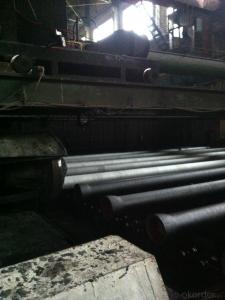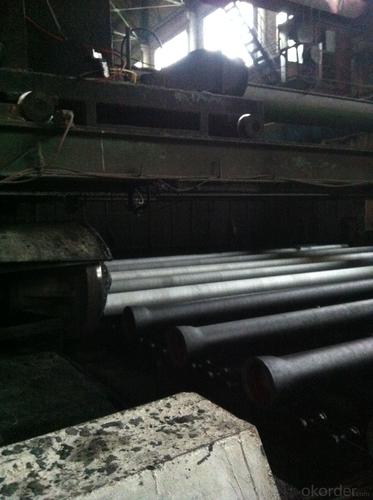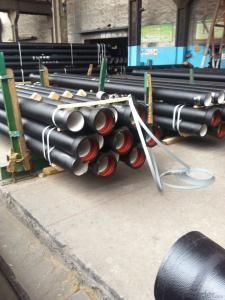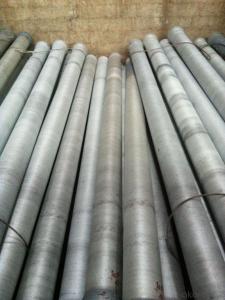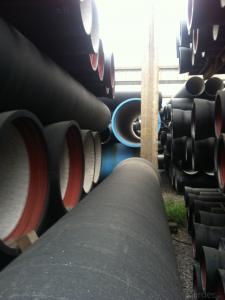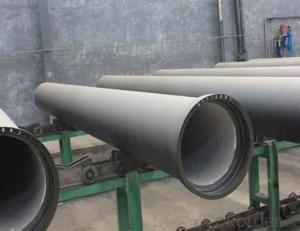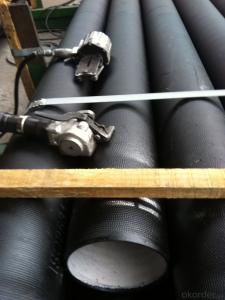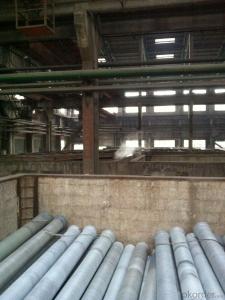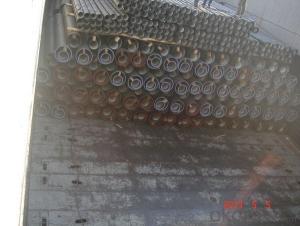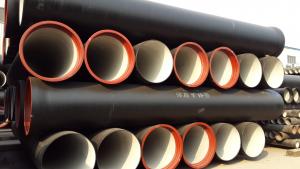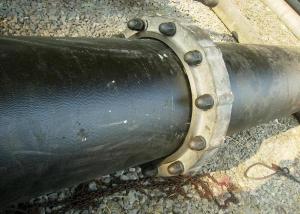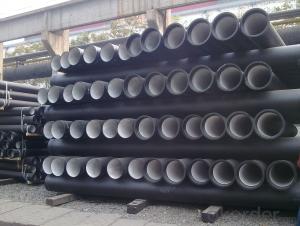DUCTILE IRON PIPE AND PIPE FITTINGS K7 CLASS DN700
- Loading Port:
- Tianjin
- Payment Terms:
- TT OR LC
- Min Order Qty:
- 32 pc
- Supply Capability:
- 3000 pc/month
OKorder Service Pledge
OKorder Financial Service
You Might Also Like
· Material : Ductile Cast Iron
· Size Range : DN 80mm to DN 2000mm
· Unit Effective Length : 6m or 5.7m
· Manufacture Standard: ISO 2531:1998/ EN 545:2006/EN 598:2007
· Annual capacity : 200,000 tons
· Coating Exterior: Zinc 130g/m2 according to ISO 8179-1 and bitumen coating 70 microns.
· Cement Interior: Portland Cement/ High Alumina Cement/ Sulphate Resisting Cement Lining according to ISO 4179
· Special requirements on external coating and internal lining can be applied
· We also provide accessories such as SBR/EPDM rubber gaskets, lubricant paste, pipe caps, PE sleeves, etc.
Additional Parts:
Each pipe is strictly inspected according to related standard to ensure permanently high performance.
Easy Installation at site and service free for life
Long Service Lifespan
Quotation will arrive you within 24hours once we get your inquiry.
We guarantee offering you a competitive price.
A copy of original inspection reports of pipes will be offered after shipment.
Photos of loading process will be sent to the customer after shipment effect.
We will follow-up the delivery progress after shipment effect and update to the customer on weekly basis.
- Q: What is the internal lining used in ductile iron pipes?
- The internal lining used in ductile iron pipes is typically a cement mortar lining.
- Q: How does ductile iron pipe handle soil movements and settlements?
- Ductile iron pipe has excellent resistance to soil movements and settlements due to its high tensile strength and flexibility. The pipe's ability to withstand soil loads and settle without compromising its structural integrity makes it a reliable choice for underground applications. Additionally, the pipe's joint design allows for some degree of movement, further reducing the risk of damage or failure.
- Q: What are the different joint restraint systems available for ductile iron pipe?
- Ductile iron pipe offers several options for joint restraint systems. These systems aim to prevent movement and separation at the pipe joints, ensuring a secure and leak-free connection. The commonly used joint restraint systems for ductile iron pipe include the following: 1. Mechanical Joint Restraint: This system involves a joint adapter and a restraining gland. The joint adapter is bolted to the pipe, while the restraining gland is bolted to the adjacent pipe or structure, preventing any movement. 2. Push-on Joint Restraint: This system uses a push-on joint along with a restraining gland that is bolted to the pipe or structure. The gland grips the pipe, providing axial restraint and preventing movement. 3. Flex-Ring Joint Restraint: This system employs a flexible rubber ring installed inside the pipe's bell. The ring expands against the pipe, ensuring a tight and secure connection by providing radial restraint. 4. Harness Joint Restraint: This system includes a harness wrapped around the pipe and connected to a restraining gland. The harness offers both axial and radial restraint, keeping the pipe in place. 5. Grip-Lock Joint Restraint: This system involves a wedge-shaped restraint inserted into the pipe's bell. The wedge expands and locks into place, providing both axial and radial restraint. 6. Restrained Joint System: This system combines mechanical and flexible joint restraints. It typically includes a mechanical joint adapter, a flexible joint restraint, and a restraining gland, offering both axial and radial restraint. Engineers typically specify these joint restraint systems based on factors like pipe diameter, operating pressure, and soil conditions. Each system has its own advantages and limitations, and the selection depends on the specific project needs and constraints.
- Q: What is the cost of ductile iron pipes compared to other pipe materials?
- Ductile iron pipes tend to be cost competitive compared to other pipe materials. While the exact cost can vary depending on factors such as pipe diameter and length, ductile iron pipes generally offer a good balance between cost and performance. They are often preferred in applications that require high strength, durability, and corrosion resistance, making them a popular choice in various industries including water and wastewater systems, oil and gas pipelines, and infrastructure projects.
- Q: Is nodular cast iron pipe filled with Yau Ma Tei?
- The main components of ductile iron pipes are carbon, silicon, manganese, sulfur, phosphorus and magnesium. Perform standard [span]GB/T13295-2003 ISO2531/2003
- Q: Which is better, ductile iron pipe and spray plastic pipe?
- Ductile iron pipe corrosion resistance, strength, it is said that the Ming Dynasty ordinary cast iron works now, and now has a new type of dedicated, can be used, construction becomes very convenient, ductile iron pipe has no effect on water quality. Plastic sprayed steel pipe is a new type of pipeline with higher price.
- Q: What is the external coating used in ductile iron pipes?
- The external coating commonly used in ductile iron pipes is a protective layer made of either cement mortar or polyethylene.
- Q: What are the advantages of using ductile iron pipe over HDPE pipe?
- There are several advantages of using ductile iron pipe over HDPE pipe. Firstly, ductile iron pipe is known for its high strength and durability. It is able to withstand higher pressure and is less likely to leak or burst compared to HDPE pipe. This makes ductile iron pipe a reliable choice for applications where high-pressure water or gas transmission is required, such as in municipal water supply systems or industrial piping networks. Secondly, ductile iron pipe has a longer lifespan compared to HDPE pipe. It is highly resistant to corrosion and can last for several decades, even under harsh environmental conditions. This reduces the need for frequent replacements, resulting in cost savings over time. Moreover, ductile iron pipe has excellent fire resistance properties. It can withstand high temperatures without compromising its structural integrity. This makes it a reliable choice for applications where fire safety is a concern, such as in fire hydrant systems or sprinkler systems. Additionally, ductile iron pipe is known for its superior flow characteristics. Its smooth inner surface reduces friction loss, allowing for efficient and consistent flow of fluids. This is particularly important in applications where maximum flow capacity is required, such as in water distribution systems or wastewater treatment plants. Furthermore, ductile iron pipe is highly recyclable. It can be melted down and reused to manufacture new pipes, reducing the environmental impact and promoting sustainability. In conclusion, the advantages of using ductile iron pipe over HDPE pipe include its high strength and durability, longer lifespan, fire resistance, superior flow characteristics, and recyclability. These factors make ductile iron pipe a preferred choice for various applications, especially those that require high-pressure transmission, longevity, fire safety, efficient flow, and environmental sustainability.
- Q: Can ductile iron pipe be used for power plant cooling water systems?
- Yes, ductile iron pipe can be used for power plant cooling water systems. Ductile iron pipe is known for its strength, durability, and corrosion resistance, making it a suitable choice for transporting water in power plant cooling systems. Additionally, its ability to withstand high pressure and temperature variations makes it a reliable option for such applications.
- Q: What is the expected corrosion rate of ductile iron pipes?
- Several factors can influence the expected corrosion rate of ductile iron pipes, including the specific environment in which they are installed, the pH and composition of the water or soil they come into contact with, and the presence of any corrosive substances or chemicals. Compared to materials like cast iron or steel, ductile iron pipes are well-known for their excellent resistance to corrosion. This is because they naturally develop a protective layer called a passive film on their surface when exposed to oxygen in the environment. This passive film acts as a barrier, preventing further corrosion. However, it is important to acknowledge that even ductile iron pipes can experience some degree of corrosion over time, especially in aggressive or highly corrosive environments. The expected corrosion rate can vary from very low to moderate, depending on the aforementioned factors. To ensure the durability and performance of ductile iron pipes, it is advisable to follow proper maintenance and monitoring practices. This includes regular inspections, cleaning, and the application of protective coatings or linings when necessary. Furthermore, implementing a cathodic protection system can further enhance the pipes' corrosion resistance. Ultimately, consulting experts and professionals in the field of corrosion and pipe materials is crucial for accurately determining the expected corrosion rate of ductile iron pipes in a specific application or environment.
Send your message to us
DUCTILE IRON PIPE AND PIPE FITTINGS K7 CLASS DN700
- Loading Port:
- Tianjin
- Payment Terms:
- TT OR LC
- Min Order Qty:
- 32 pc
- Supply Capability:
- 3000 pc/month
OKorder Service Pledge
OKorder Financial Service
Similar products
Hot products
Hot Searches
Related keywords
